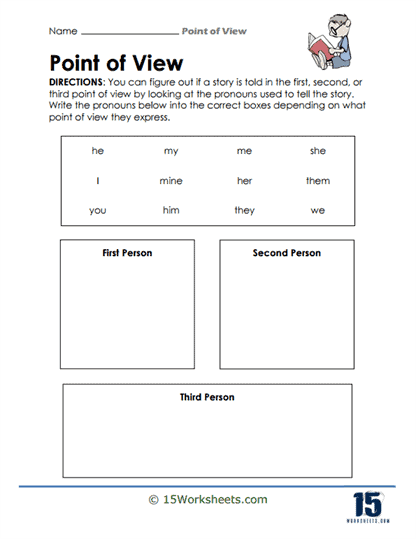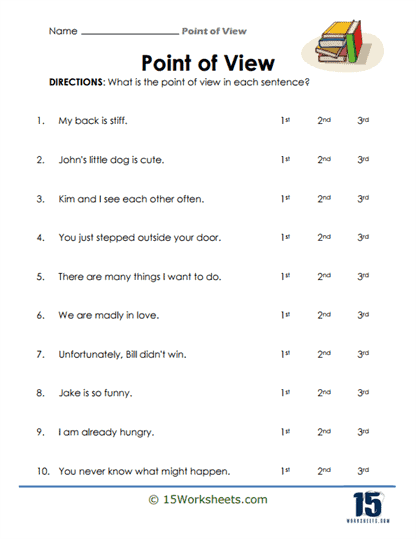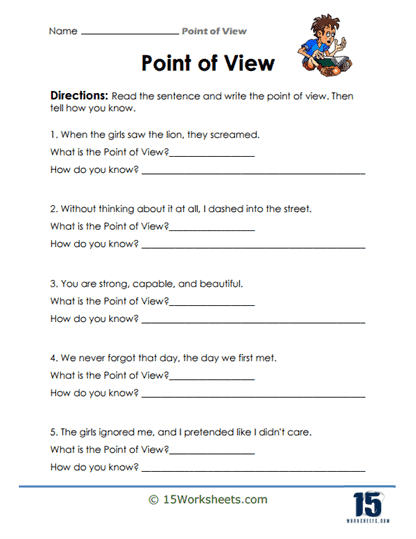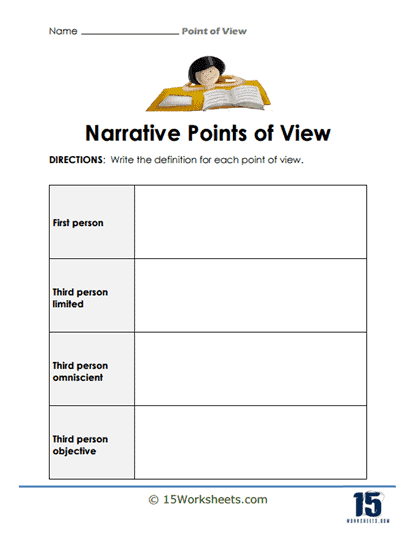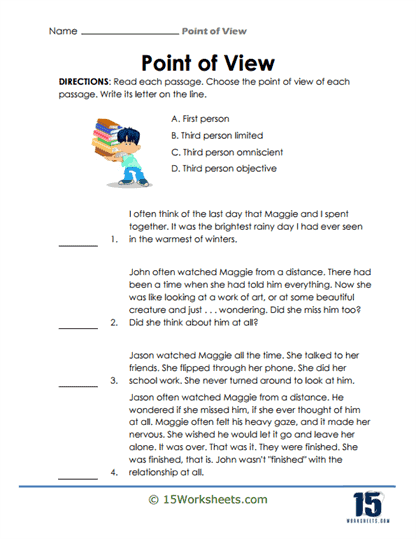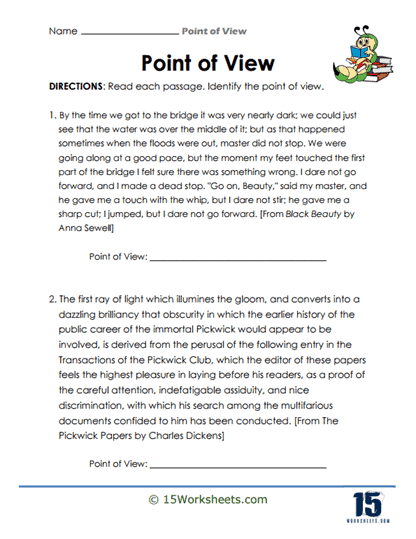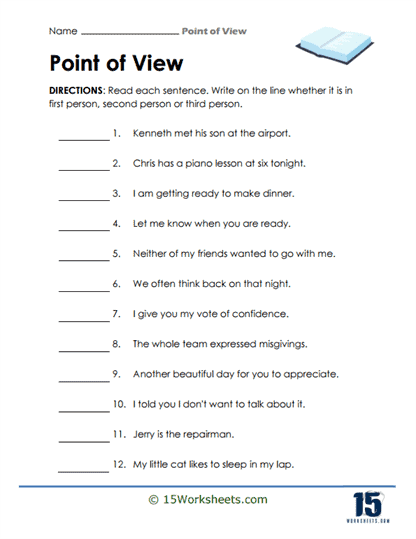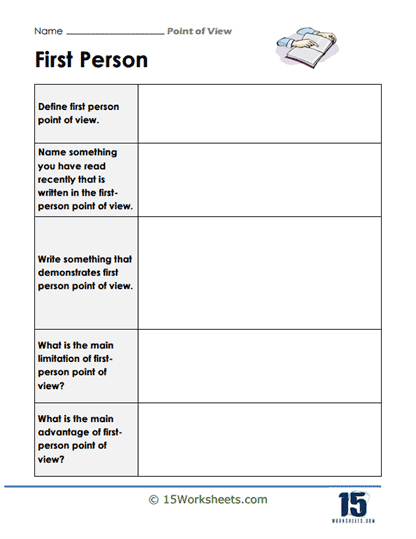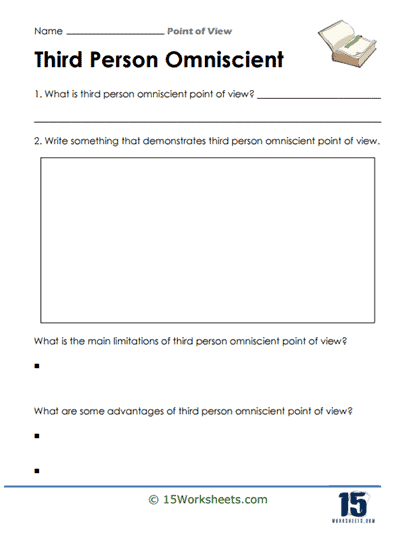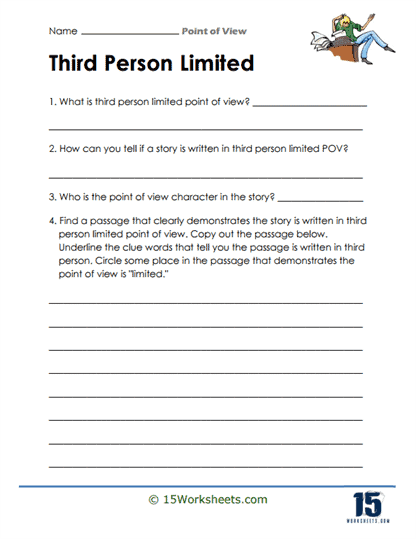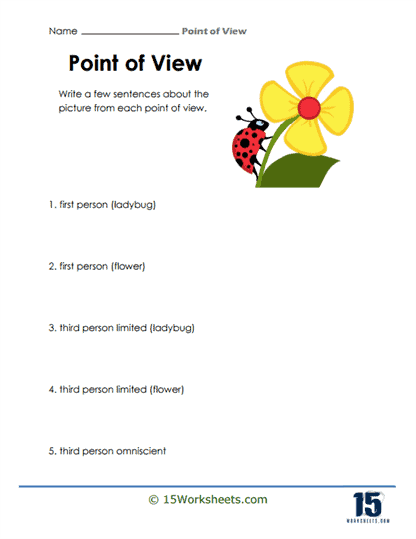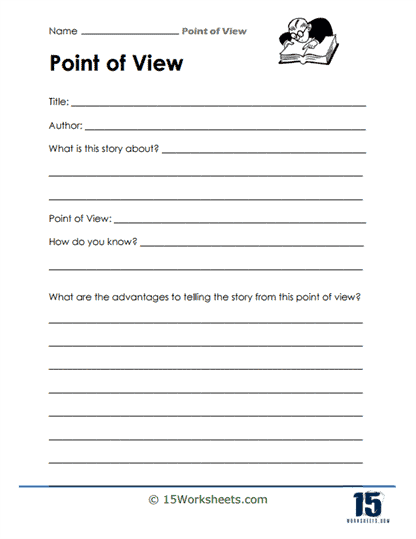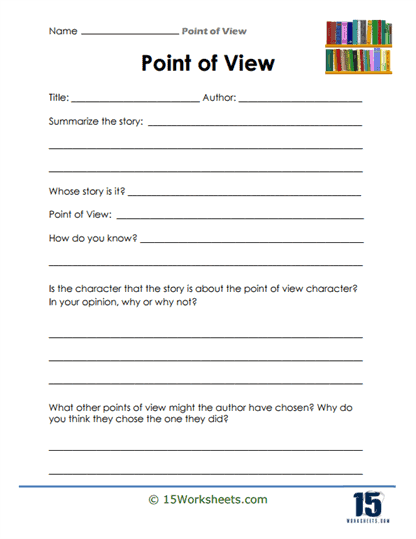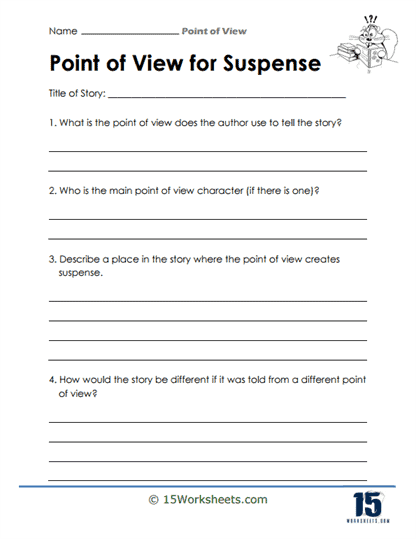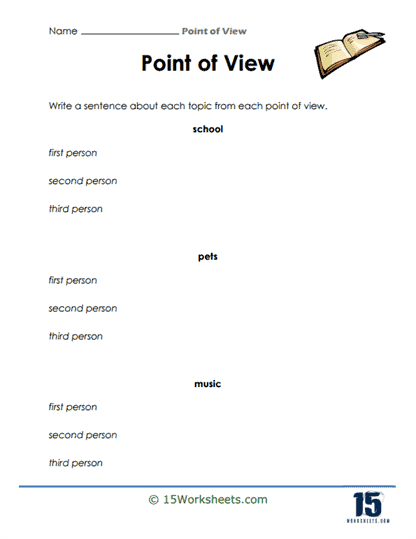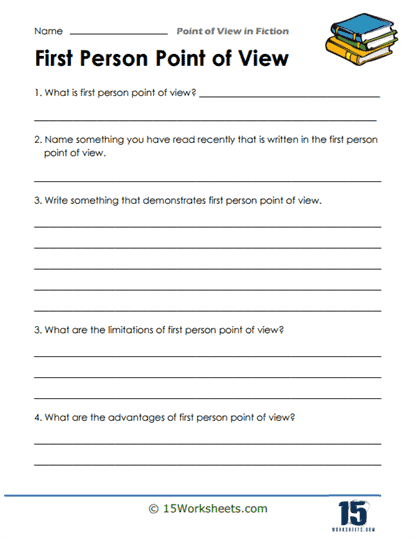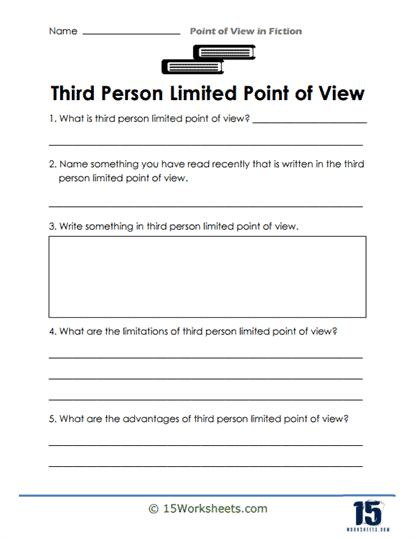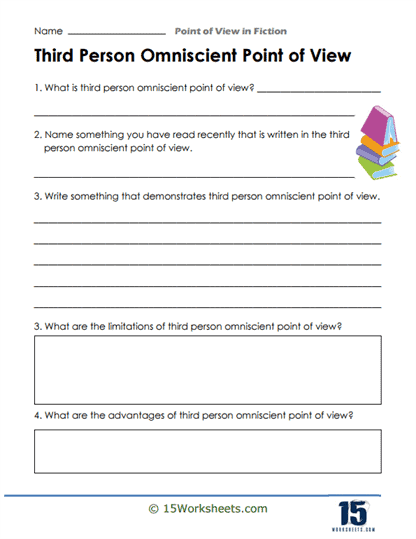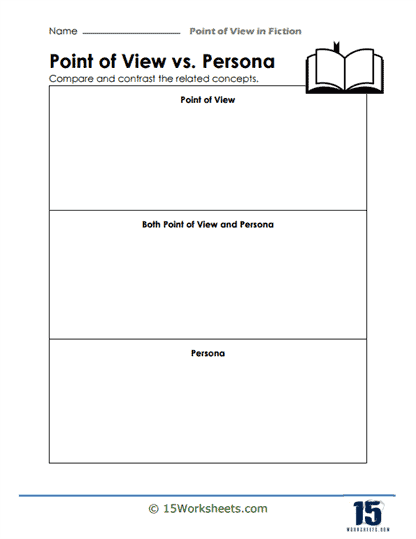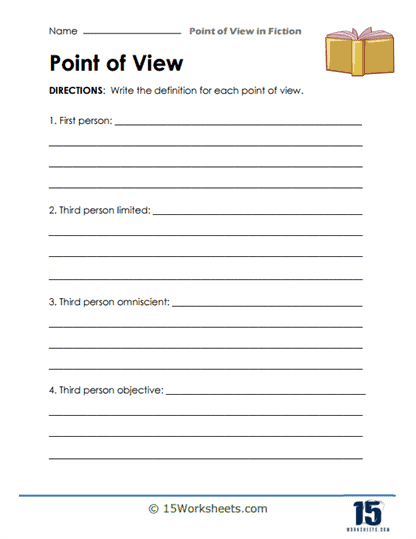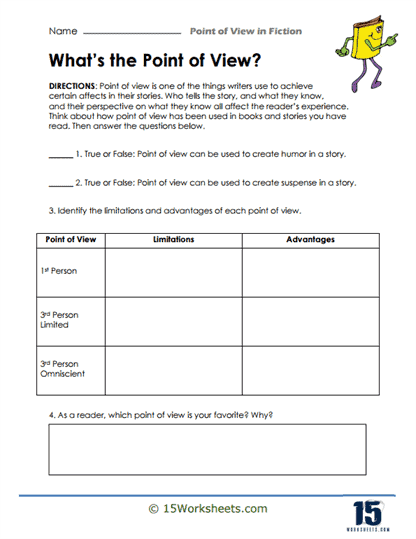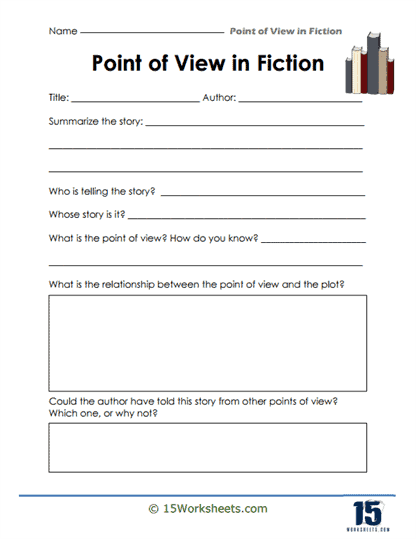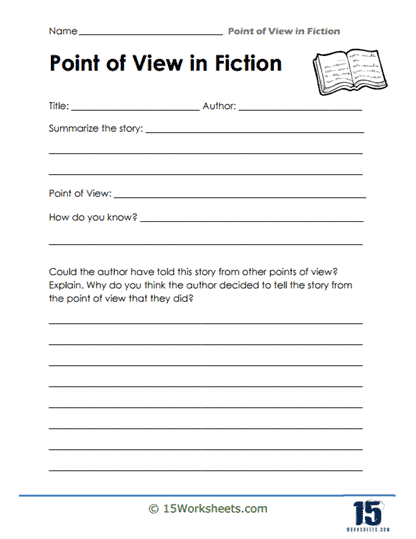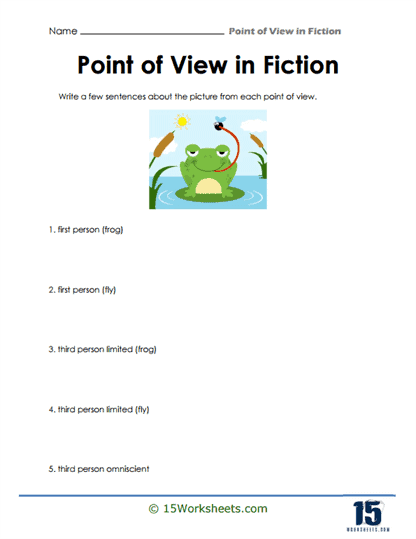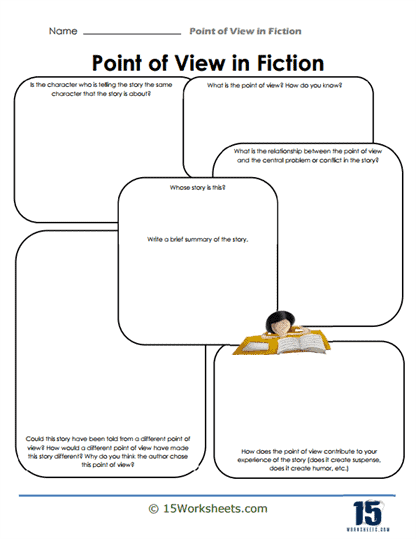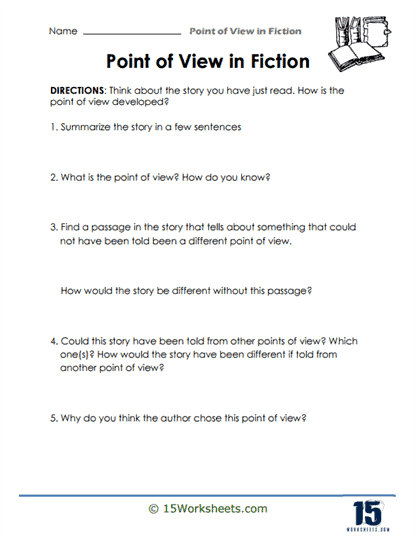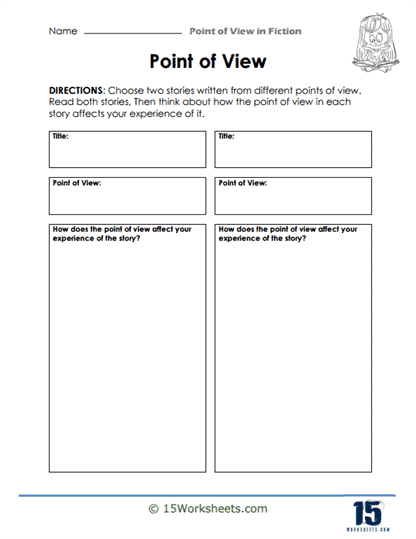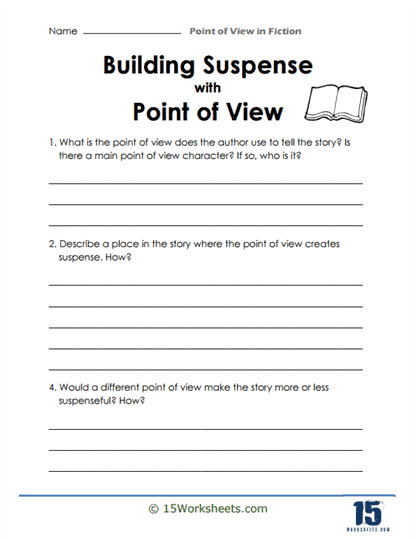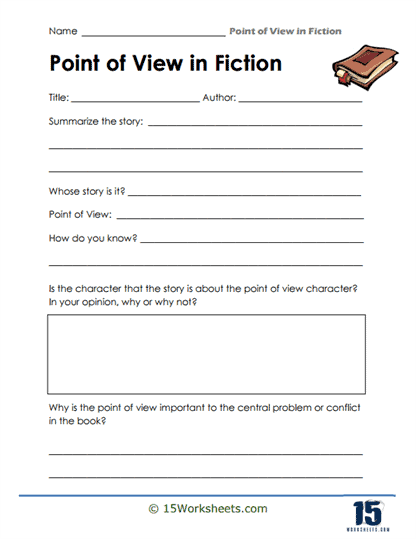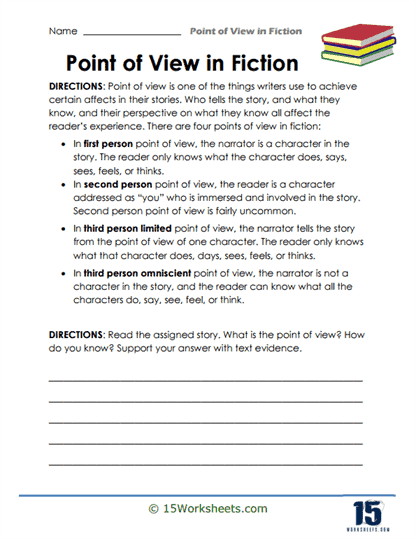Point of View Worksheets
All About These Worksheets
This series of worksheets will help students understand and analyze different perspectives from which a story or text is narrated. In literature and writing, the point of view refers to the vantage point from which the events and thoughts in a story are presented. It determines how much the reader knows about the characters’ thoughts, feelings, and motivations, and it shapes the reader’s connection to the narrative. Common points of view include first-person, where the narrator is a character within the story using “I” or “we”; second-person, which uses “you” and is rarely seen in fiction; and third-person, where the narrator is outside the story, using “he,” “she,” or “they.”
These worksheets help students recognize these perspectives and understand how each one influences the reader’s experience of the story. By working through these worksheets, students learn to identify the narrator’s position in a story and analyze how the choice of point of view affects the storytelling. Whether a story is told through the limited knowledge of a single character or from the all-knowing perspective of an omniscient narrator can drastically change how events and characters are understood. Mastery of point of view is crucial for students to develop deeper reading comprehension and to enhance their own writing skills.
The Benefits of These Worksheets
Point of view worksheets are incredibly effective in improving reading comprehension. Understanding the point of view of a story helps students make sense of what they are reading, as it directly impacts how the reader processes information. For instance, a story told in the first person is limited to the narrator’s thoughts and experiences, which may cause readers to question the reliability of the information. Conversely, a third-person omniscient narrator can reveal the inner thoughts of multiple characters, giving readers a broader understanding of the narrative. By using point of view worksheets, students learn to pay close attention to who is telling the story and what that means for the reader’s interpretation of events.
This collection will encourage students to engage in critical thinking. When students analyze point of view, they must consider how the narrator’s perspective shapes the overall story. For example, a student might explore how the point of view affects the reader’s perception of a character’s motivations. In a first-person narrative, the protagonist’s personal biases and feelings may color the way events are presented, while in third-person omniscient, the reader may get a more balanced view of all characters. This type of analysis helps students think critically about the author’s choices and their impact on storytelling, which is a vital skill for understanding literature at a deeper level.
These worksheets also enhance writing skills by teaching students how to use different perspectives in their own writing. When students understand how point of view influences a narrative, they can experiment with these techniques in their own stories. For example, they might write a short story from the first-person perspective of a character and then rewrite it from a third-person point of view to see how it changes the tone, focus, and depth of the story. This practice helps students become more versatile writers, as they learn how to control the reader’s experience by choosing the appropriate point of view for their narrative.
Types of Exercises
Point of view worksheets typically contain a variety of exercises that help students recognize and analyze different narrative perspectives. One common exercise is identification. In this activity, students are presented with short passages from various texts, and they must identify the point of view being used. For example, they might read a passage from a first-person narrative where the character uses “I” and then label it as first person. Similarly, students might encounter a passage that uses “he” or “she” but provides insights into multiple characters’ thoughts, indicating third-person omniscient. This exercise helps students become familiar with the different narrative perspectives and trains them to recognize point of view quickly in any text.
Another popular exercise involves rewriting sentences or passages from one point of view to another. For instance, students might be given a passage written in the first person and asked to rewrite it from the third person. For example, a sentence like “I felt nervous as I entered the room” could be changed to “She felt nervous as she entered the room.” This activity encourages students to understand how pronouns change depending on the point of view and how perspective shifts affect the tone and focus of a story. Through this exercise, students also practice using different narrative voices in their writing, enhancing their versatility as writers.
Point of view worksheets include comparison exercises, where students analyze how different points of view affect the reader’s understanding of a story. For example, students might read two versions of the same event—one told in the first person and another in third-person limited—and compare how the point of view changes the details provided or the emotional impact on the reader. This exercise helps students develop an understanding of the strengths and limitations of each point of view. They learn that a first-person narrator may give more intimate details about their emotions but may be unreliable, while a third-person limited narrator provides a slightly broader view but still limits the reader to one character’s perspective.
These worksheets also include passage analysis. In this type of exercise, students read a longer excerpt from a story or novel and answer questions about how the point of view influences the reader’s experience. For instance, students might be asked questions like, “How does the first-person point of view limit what the reader knows about the other characters?” or “How does the use of third-person omniscient help the reader understand multiple characters’ motivations?” These analytical questions encourage students to think deeply about how point of view shapes the overall narrative and guides their interpretation of the text.
Some worksheets contain creative writing prompts designed to encourage students to experiment with different points of view. For example, students might be asked to write a short story about a day at the park from the perspective of a dog (first-person), then rewrite the story from the perspective of the dog’s owner (third-person limited). This type of exercise allows students to play with how perspective shapes the reader’s relationship to the narrator and the events of the story. It also encourages students to explore how different narrators experience the same events differently, based on their knowledge, feelings, and biases.
Helping Students Improve Their Point of View Recognition
Helping students improve their ability to understand the point of view in a story is a key aspect of developing their reading comprehension and critical thinking skills. To do this effectively, teachers can take a step-by-step approach that makes learning both fun and engaging. By incorporating interactive activities, relatable examples, and creative exercises, teachers can make the concept of point of view accessible to students of all levels.
Start with a Simple
The first step in teaching students about point of view is to provide a clear and simple explanation of the different types of perspectives a story can have. Teachers can begin by introducing the three most common points of view: first-person, second-person, and third-person. To make this more relatable, the teacher can use familiar stories, such as popular children’s books, TV shows, or even experiences from the students’ own lives.
For instance, the teacher could start by reading a passage from a well-known first-person narrative, such as Diary of a Wimpy Kid, where the narrator uses “I” to tell the story. Then, the teacher could compare this to a passage from a third-person narrative, such as Harry Potter, where the story is told using “he” or “she.” By using examples from books the students may already know and enjoy, teachers make the initial introduction to point of view more engaging and easier for students to grasp.
Use Interactive Discussions and Questions
Once students have a basic understanding of the different points of view, the teacher can engage them in interactive discussions. Asking open-ended questions about how point of view affects the story helps students think critically about the narrator’s role. For example, the teacher could ask, “How would the story change if it were told from another character’s perspective?” or “What information does the narrator have that others don’t?” These types of questions encourage students to reflect on how point of view influences the reader’s experience of the story.
To make this discussion more interactive, the teacher might use technology or classroom tools such as interactive whiteboards. For example, the teacher could present a short story on the board and ask students to highlight sentences that give clues about the point of view. Then, students could take turns coming up to the board to mark the pronouns that reveal who is telling the story. This hands-on approach helps students see how point of view shapes the narrative and keeps them actively engaged in the learning process.
Incorporate Group Activities
Group activities can be highly effective in teaching point of view, as they allow students to collaborate and share ideas. One activity that works well is having students work in pairs or small groups to retell a familiar story from a different character’s perspective. For example, after reading a classic fairy tale like Little Red Riding Hood, the teacher might ask each group to rewrite the story from the wolf’s perspective, the grandmother’s perspective, or even the woodcutter’s perspective. This activity not only helps students practice identifying point of view but also taps into their creativity and gives them a deeper understanding of how different narrators can influence the story.
Another fun group activity is to play “Guess the Narrator.” In this game, the teacher reads a passage aloud without revealing the narrator’s identity, and students must work together to determine whether the passage is written in first-person, second-person, or third-person. As they discuss their ideas with their group, they can use clues like pronouns, tone, and the narrator’s knowledge of events to figure out the point of view. This collaborative approach encourages peer learning and helps students develop confidence in analyzing narrative perspective.
Use Creative Writing to Reinforce Understanding
Creative writing exercises are a fantastic way to help students improve their ability to understand and work with point of view. After students have had some practice identifying different points of view, the teacher can challenge them to write their own short stories from multiple perspectives. For example, the teacher might give students a simple story prompt, like “A day at the zoo,” and ask them to write three short paragraphs: one from the first-person perspective of a child, one from the third-person limited perspective of a zookeeper, and one from the third-person omniscient perspective of an all-knowing narrator.
This exercise allows students to actively experiment with different narrative voices and gives them firsthand experience with how point of view shapes the way a story is told. By switching between perspectives, students gain a better understanding of how a narrator’s knowledge, biases, and emotions influence the narrative. Creative writing also helps students explore the flexibility of point of view and allows them to play with tone, detail, and focus in their stories.
Use Technology and Visual Tools
Incorporating technology and visual tools can make learning about point of view more engaging for students, especially those who are visual or hands-on learners. For example, teachers can use story sequencing apps or digital storytelling platforms to show how point of view influences a narrative. These tools allow students to drag and drop narrative elements and experiment with changing the narrator’s perspective, providing instant feedback on how the story shifts.
Another visual tool could be a “Point of View Chart” where the class collectively tracks different narrators in a story. For example, the teacher could create a chart listing characters and their perspectives in a book the class is reading together, such as Wonder by R.J. Palacio, which is told from multiple first-person points of view. As students read the book, they can fill in the chart to track each character’s perspective, noting how their views shape the reader’s understanding of the plot and themes. This visual representation makes the abstract concept of point of view more concrete and helps students organize their thoughts more clearly.
Use Reflection
To deepen students’ understanding, it’s important to encourage reflection on how point of view affects storytelling. After students have completed activities like retelling stories from different perspectives or writing their own narratives, the teacher can lead a reflection session where students discuss what they learned about point of view. Questions like “How does the narrator’s perspective influence how the reader feels about the characters?” or “What information is the narrator hiding or leaving out?” help students think critically about the relationship between the narrator and the reader.
This reflection can be done through classroom discussions or writing exercises, where students explain how their understanding of a story changed based on the point of view. For example, after rewriting Little Red Riding Hood from the wolf’s perspective, a student might reflect on how this change made the wolf more sympathetic, highlighting how point of view affects our perception of character motivations. These reflection activities help students connect the concept of point of view to broader ideas in literature and storytelling.
By using relatable examples, visual aids, and technology, teachers can make the concept of point of view accessible and fun for students. Through hands-on activities such as retelling stories, playing games, and experimenting with narrative voice, students develop a deeper appreciation for how the choice of point of view shapes the reader’s experience of a story. As they become more confident in identifying and using different perspectives, students not only improve their reading comprehension but also enhance their writing skills, becoming more thoughtful and versatile writers.

